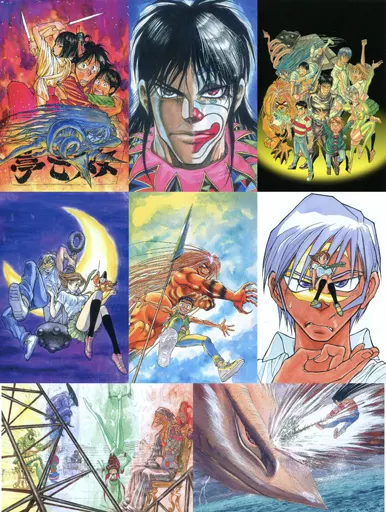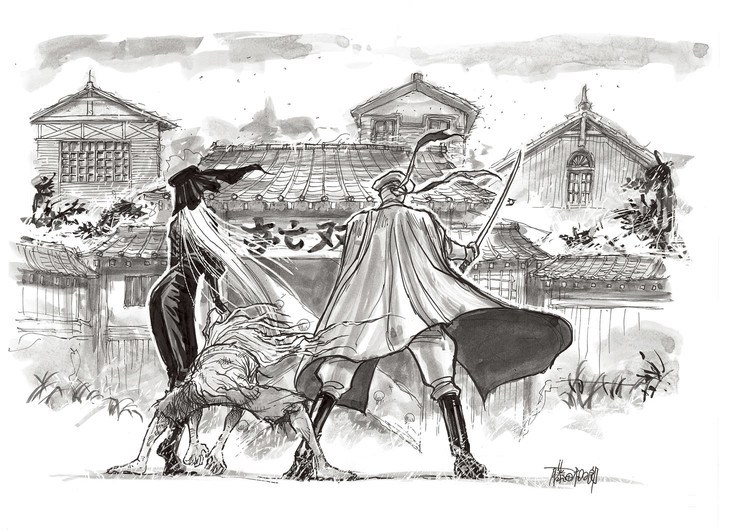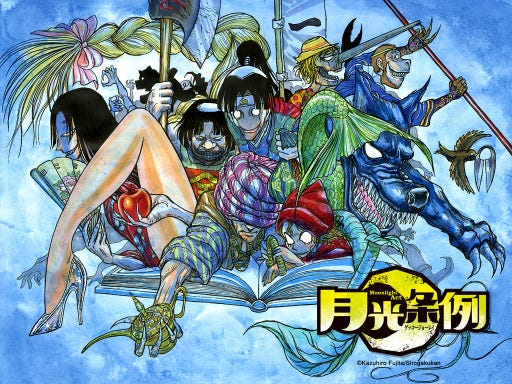I've had the opportunity to write about legends in the Weekly Shonen Sunday sphere as of late here on the blog, and perhaps Kazuhiro Fujita is one of the biggest. (While I'd love to write a “New to Sunday” article about Adachi and or Takahashi, the likelihood of them starting a new series in WSS is pretty low, sadly.) Where do I even begin with this one? I'm in a weird place where Fujita is known enough where I don't have to dig too deep into his past, but not well enough known to have anything licensed in English. I'm not bold enough to believe this one article could change things, but if it's a start, I'll take that.
The Author
Kazuhiro Fujita
Fujita-sensei was born May 24, 1964, in Hokkaido, Japan. Despite his manga often depicting hot-blooded protagonists in impossible situations, he's actually a well-read mangaka One of his inspirations was American science fiction writer Roger Zelazny --specifically his book Damniation Alley (known as “Highway to Hell” in Japanese.) Heck, for his later work Souboutei kowasubeshi his inspiration came from Richard Matheson's novel Hell House and Polish sci-fi writer Stranislaw Lem's Solaris. Let's not get it twisted, though, he is a manga devotee through and through --and his path was decided after reading Rumiko Takahashi's story Yami wo kakeru manasashi. He even studied martial arts under the older brother of famed anime director Mamoru Oshii! He made his first debut in 1988 with a oneshot that won the 22nd Shogakukan Rookie award, and a prototype of his first series Ushio and Tora won second place in the 2nd annual Shonen Sunday Comics Grand Prix. Which lead to the legendary serialization that began in WSS in 1990 and ended in 1996, while the series would get an OVA in the 90s, it wouldn't get a proper TV anime until 2015. This would be the same for his next series Karakuri Circus that ran from 1997 to 2006 in Weekly Shonen Sunday and receive an anime in October 2018. Afterward he'd leave Shogakukan for his only series to be released in English: Black Museum: The Ghost and the Lady which is part of a longer Black Museum ethos, (which even there we didn't get more than the one series of) before returning to Sunday with Gekkou Jorei from 2008-2014, and then Souboutei Kowasubeshi from 2016-2021.

Fujita's Weekly Shonen Sunday works from Ushio to Tora to Souboutei Kowasubeshi.
Quite the introduction! But when you've been with a magazine for more than 30 years, it comes with the territory. To go through each one of his series one by one would be the ideal, but it'd take a crazy amount of time, so unfortunately you'll have to make do with this rundown. Characteristic of Fujita's artwork is his incredible line art --all done in one go. That's right, he doesn't necessarily use pen work to lay a foundation down before drawing over that, he just goes for it, which is all that much more impressive and perhaps what leads to his art having a wild and untamed quality to it.

From Souboutei Kowasubeshi

From Gekkou Jorei (Moonlight Act)
His frienemy (YMMV) is Kazuhiko Shimamoto (of which we have an interview between the two here) their “bond” goes back so far that they planned and announced their two serials together --right down to them starting in the same issue of WSS! I'll have more to say about Shimamoto in the write-up for his new series Vampidol Tagiru, but the two have gone way back.
Aww, look at how well they get along on the first issue of the double serialization.
The Serial
Silver Mountain
Beginning in issue #23 of Weekly Shonen Sunday is Kazuhiro Fujita's newest series, Silver Mountain. The original tagline for the series stated it was a series about being whisked away to a land of martial arts mastery.
The Premise.
So something I didn't know until I sat down to do research is that this series is based off a true(?) story. (A Real Fairy Tale?) Fujita-sensei being well-read strikes again! The real Torakichi was supposedly whisked away by a tengu and famous scholar Atsutane Hirata interviewed him regarding his experiences and recorded them in a book, the Senkyo Ibun in 1822. If you're interested in the story behind the story, there is a book When Tengu Talk: Hirata Atsutane's Ethnography of the other world by Wilburn Hansen that discusses the Senkyo Ibun in detail. I plan on sitting down with it after I'm done here, and I'd recommend it to readers who are interested in Fujita's inspiration.
Back to the subject at hand. The story starts in 1822 where, as stated above, Torakichi is a 15-year-old boy who was apparently kidnapped by a tengu, and is in the midst of an interview about his tale. Torakichi seems like a normal, if not astute, young man and Hirata wants to know all about his time with a tengu. He asks Torakichi to follow him home so they can talk, but they're attacked by a wandering samurai who in a peaceful era has lost his purpose (as was the style at the time) but Torakichi easily takes him down…his vibe totally different from before. Turns out he's an old guy trapped in a kid's body (Meitantei Torakichi, anyone?) and begins to tell the true story of the Silver Mountain….
So the initial premise lifted from the Senkyo Ibun goes this far. What happens after is a quasi time-travel, isekai martial arts story about two old men who just can't avoid throwing hands with each other despite their age. The tengu, for one reason or another, wants them dead so bad that it picked them up and dropped them into another world to increase the chances of their demises.
The Tengu in question
Our Protagonists.
From the start, the fact that the protagonists are old men (who admittedly quickly get de-aged to characters more befitting of the shonen demographic) stands out. That being said, these two squabble like teenagers, so one shouldn't put too much stock into their ages. Furthermore, there's the twist in a familiar story --it starts off exactly like the aforementioned tale of the Senkyo Ibun, but then becomes an entirely different and inventive tale of wild creatures and lands. As it goes with these stories it's hard to tell where this'll end up. That being said, we're given dollops of information through the Tengu's dialogue, it's strange hatred of the Gin and Hyou the two old men turned into teenagers, and the two guys themselves. Fujita's storytelling doesn't as much keep up with the times as it does into its own category that evolves alongside our world, and that is ever more evident with Silver Mountain. It has the vibe of a story that should be in 90s Shonen Sunday, but doesn't feel dated in the least, and that in large part has to do with Fujita's bombastic artwork.
The setting of Silver Mountain.
The Protagonists, shrunk!
Fujita-sensei's artwork looks incredible no matter what series it's in or what era it's serialized in. For the most part, it hasn't changed since the Ushio and Tora days, but that's to its benefit. You know what to expect from any series he illustrates, to the point that it's similar to an artistic handshake --if it's Fujita-sensei, it's gonna be good. Rather, it's his storytelling that gets more ambitious with every work he serializes. Silver Mountain goes from a retelling to something entirely different by the end of its second chapter, and we've barely scratched the surface of why. The what and who have been firmly established, but in true Shonen Sunday style meticulous pacing, there's no hurry to drop huge twists just to keep readers guessing. Rather, what keeps one hooked (aside from the Fujita-sensei handshake) is just how many mysteries surround the world of the mountain and the characters who inhabit it. For example, the people of this world have no idea what “martial arts” as we know them are, and instead speak like throwing hands is a foreign concept. Gin and Hyou being retired martial artists in their own right gives the series a shonen “structure” in the sense that they're battle hungry (at least Hyou is due to his grudge against Gin). Add to that a mysterious woman who believes in rituals and rites, and you've got enough to keep this climb up the enigmatic mountain going. There's a reason why he's been in the game so long, and it's all here in bold display. Martial Arts? Isekai? Time Travel? Only Fujita-sensei could make all of these work together in tandem. As an aside, I find it interesting that while at first the tengu speaks in a mysterious aged vibe, later it's vibe and speech matches that of a modern Japanese person. The mystery deepens....
The Japanese Connection.
I don't think readers of this blog will be surprised to hear that Japanese readers have almost unanimously heaped praise upon the series. Fujita being back in Sunday is treated with the same level of awe and rapture as going to church each week or celebrating one's birthday. More than one reader has stated “This is what shonen manga is all about” and that this is the best first chapter Fujita-sensei has released ever. I think I agree with that --recontextualizing a fairytale known well to Japanese readers and adding a modern fare is an incredibly ambitious start to this work. In short, people are incredibly happy to see Fujita-sensei back home again.
The Verdict
Artists becoming more ambitious as they become more experienced with storytelling and find their voice is natural. In that way I think agree with Japanese readers in that this is Fujita-sensei's best first chapter, though if he intends to keep returning to Sunday, I think he can still one up himself again. However, let's keep our focus on this serial. Even without the context of the Japanese story it's based upon, Fujita's take on this story --that an olden fairy tale (?) is being recited by an old man who's been de-aged and stuck in a previous era, is already enough of a hook. Add to that his wild, untamed and fascinating artwork, and characters that are fun and funny to watch, and you've got another legend in the making. I can only hope that someone will have mercy on English-speaking audiences and bring this over in print for us all to enjoy. Until that day comes, however, you can be sure that I'll keep yelling about Silver Mountain over on the twitter each and every week. I feel honored to have the right to experience my very first Fujita serial from beginning to end, and I want to share that with as many people as possible.










Comments
Post a Comment